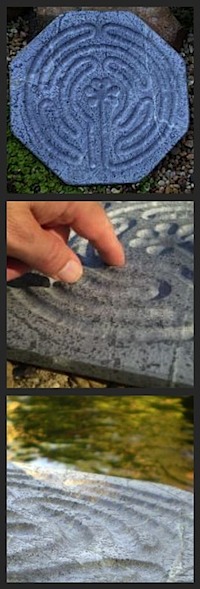What is a labyrinth?
A labyrinth is an ancient winding path used for meditation and prayer. Labyrinths are found in many cultures, some dating back 3000 years. The use of labyrinths was incorporated into early Christian practice. The first known Christian labyrinth dates to 324 A.D., when a labyrinth was installed in the floor of the Basilica of St. Reparatus, Al-Asnamin now Algiers. Perhaps the most famous labyrinth is found at the Cathedral in Chartres. It was installed around 1220 A.D. Many cathedrals house beautiful examples of labyrinths even today. Labyrinths are undergoing a renaissance now as people turn to meditative and centering practices to help them cope with our complex and demanding world.
What is a finger labyrinth?
Finger labyrinths allow you to bring this ancient meditation experience into your home or workplace. These simple guides help to move your heart and mind to a place of centered calm conducive to prayer and meditation. Every labyrinth I carve is one-of-a-kind because of the unique qualities of the soapstone. When shaping a labyrinth, my goal is to blend the natural beauty of the stone with the ancient pattern of the labyrinth to create a work of art - all with the goal of calming and inspiring you.
How do I use a labyrinth?
Take a moment first to begin the process of centering yourself. You may want this to be a time of meditation, of prayer, or of reflection.
1. Going inward: Release Place your finger in the groove at the entrance to the labyrinth, and then begin to trace your way inward. Some find it helpful to try to go a little slower than their natural tendency. Release any cares or concerns which distract you from that which is most important. For some, the image of laying cares at the feet of God is helpful.
2. In the center: Receive. Allow your finger to rest in the center, perhaps moving one by one to the center petals. This can be a time of still meditation, the "be still and know that I am God" time.
3. Moving back out: Return to your daily life. Trace outwards to the beginning point. This can be a time of reflection on the meaning of your meditation time; a time to take notice of ways that you can change as a result of this experience.
Flaws
All of the soapstone labyrinths contain so-called "flaws" in the stone - lighter colored veins which flowed into cracks while the stone was forming. Each labyrinth is unique, some with small veins and some with large. The stone tends to look medium grey in most light, with a blue hue coming out in certain conditions.
For the artist, flaws present a challenge because they throw the carving tools off the desired path. And yet, these veins of stone provide a great touch of individuality to each labyrinth. No two are identical.
How do I care for my labyrinth?
Normal wear - with time and regular use, your labyrinth will likely develop a slight patina in the groove where your finger travels as natural oils from your hand settle onto the surface of the stone. This is normal and adds to the appearance of your labyrinth.
Scratches - small scratches can be sanded out with emory cloth or a very fine grit sand paper.
Cleaning - rinse with water and air dry. If you wish to remove the patina, gently wash with dish soap. Avoid abrasives.
Warming - you can warm up your labyrinth by running warm tap water over it. After a couple of minutes, dry it off and the stone will hold an enjoyable warmth as you use it - very nice in winter time.

